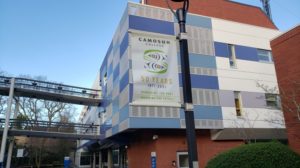Born out of an idea conceived in 2019, Camosun College faculty, staff, and a steering committee of 15 members are working together to decolonize English placement assessments. With input from the college community and support from eight Canadian institutions, the Indigenizing English Placement Assessment (IEPA) project aims to create an inclusive and equitable environment to alleviate anxiety for prospective Indigenous students by including multimodality and storytelling traditions in assessments.
Camosun instructor and English placement counsellor Maureen Niwa is a founding member of the IEPA steering committee. She sees herself as a facilitator during the process, setting the groundwork and connecting community members to the initiative. Having been inspired by her work within the Lansdowne Assessment Centre and her drive for inclusivity in postsecondary education, she believes the tool will provide a more comfortable experience to better reflect Indigenous student abilities.

Camosun students are currently offered several alternative placement assessments designed specifically with different populations in mind. However, Niwa says that there has yet to be an assessment developed for Indigenous students, expressing Indigenous worldviews.
“We have all these different assessments and assessment tools for our different populations, but nothing yet for Indigenous students. So we were really seeking for an assessment tool that reflected Indigenous worldviews and that is something that would be engaging and that would be friendly and comfortable and familiar for Indigenous students as they transition into postsecondary, given that assessment can be a nerve-wracking experience for some. And, of course, we want students to show what they know and to do the best they can,” she says. “So making a tool that is appropriate, culturally appropriate, and works for them is our goal.”
Placement assessments prepare students by evaluating where strengths and weaknesses lie. Niwa says assessment tools allow students to be accurately introduced to the postsecondary school education level, inspiring confidence and success, whereas being improperly prepared can lead to emotional and financial discouragement.
“[Indigenous students] can internalize that sense of not being prepared and not being ready, get really discouraged and drop out,” says Niwa. “The education ends. But the debt that they’ve incurred for not being placed in a good way doesn’t go away. And so you may be stuck, you know, working minimum wage to try to pay off maybe a student loan or a debt, and you’ve got nothing to show for it.”
Niwa feels a personally reflective design in postsecondary education is important for Indigenous students to share honest and sincere writing in a comfortable environment.
“I think we’ve all been in that position where we possibly confront a question, let’s say, on a midterm or for an interview, and we don’t really know what to say,” she says. “We’re not sure because we don’t have that lived experience—we just don’t have that inner knowledge, and so we’re forced to respond very inauthentically. We’re trying to make it up, impersonate someone or something that we’re not. And that’s a very uncomfortable position to be in. And so that’s why it’s so important for students and Indigenous students to see their worldview reflected, that they know that they can share who they are and what they know.”
Niwa says the standard English placement assessment currently available to students is American-based—lacking Indigenous reading passages and writing prompts, and featuring a heavy bias toward materialistic, individualistic, and capitalistic topics. The current tool also contains potentially harmful language, putting Indigenous students in an unsafe position.
“The American-based tool also has not been looked at with an Indigenous lens. So much of the language can be very triggering, offensive, potentially, and there are no choices,” she says. “So the triggering language and the lack of choice is, again, something that we would like to decolonize. So really, making sure that all the language that we use in the process and the tool is sensitive to intergenerational trauma, that’s very important that choices be built into the assessment.”
Retired Camosun Indigenous advisor, instructional assistant, and program leader Wendy McDonald is another founding member of the IEPA project. McDonald, who says the idea behind IEPA has been in the works for around 30 years, looks forward to seeing how the Indigenized assessment will better include Indigenous peoples and values.
“My hope is that [Indigenous students] can do an assessment like this, see themselves in it, and then just tell their story in a good way without just struggling with it,” she says.
McDonald says the addition of Indigenous-focused content in BC’s high-school education curriculum is not reflected in the assessment for postsecondary. She says this is more reason to develop IEPA.
“The BC government has done all this work in creating programs like First Peoples English 10, First Peoples English 11, First Peoples English 12… They’ve been working on those programs, the curriculum for that… for years and years,” she says. “And so if you think about all the work that’s been done on that, so when a student takes those courses, for them to come to the college and not see any of that curriculum reflect[ed] in the assessment, it just seems so weird.”
McDonald believes course assessments to be no different than physical assessments—training and exercising to ensure a capable student. She hopes to remove the stigma students have about assessments that may cause resistance to the resource.
“What I always tell students,” says McDonald, “is that the assessment is your friend.”
